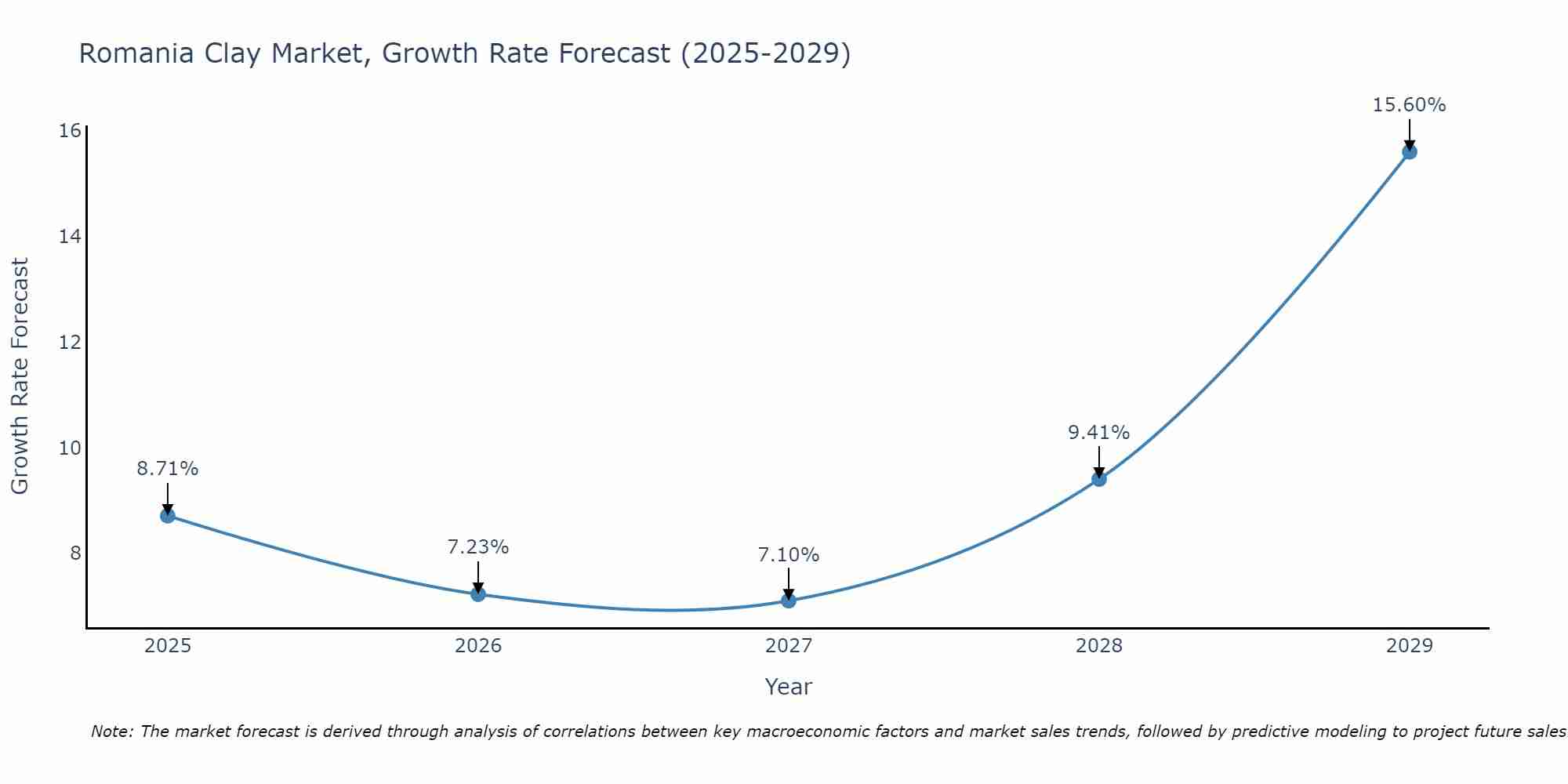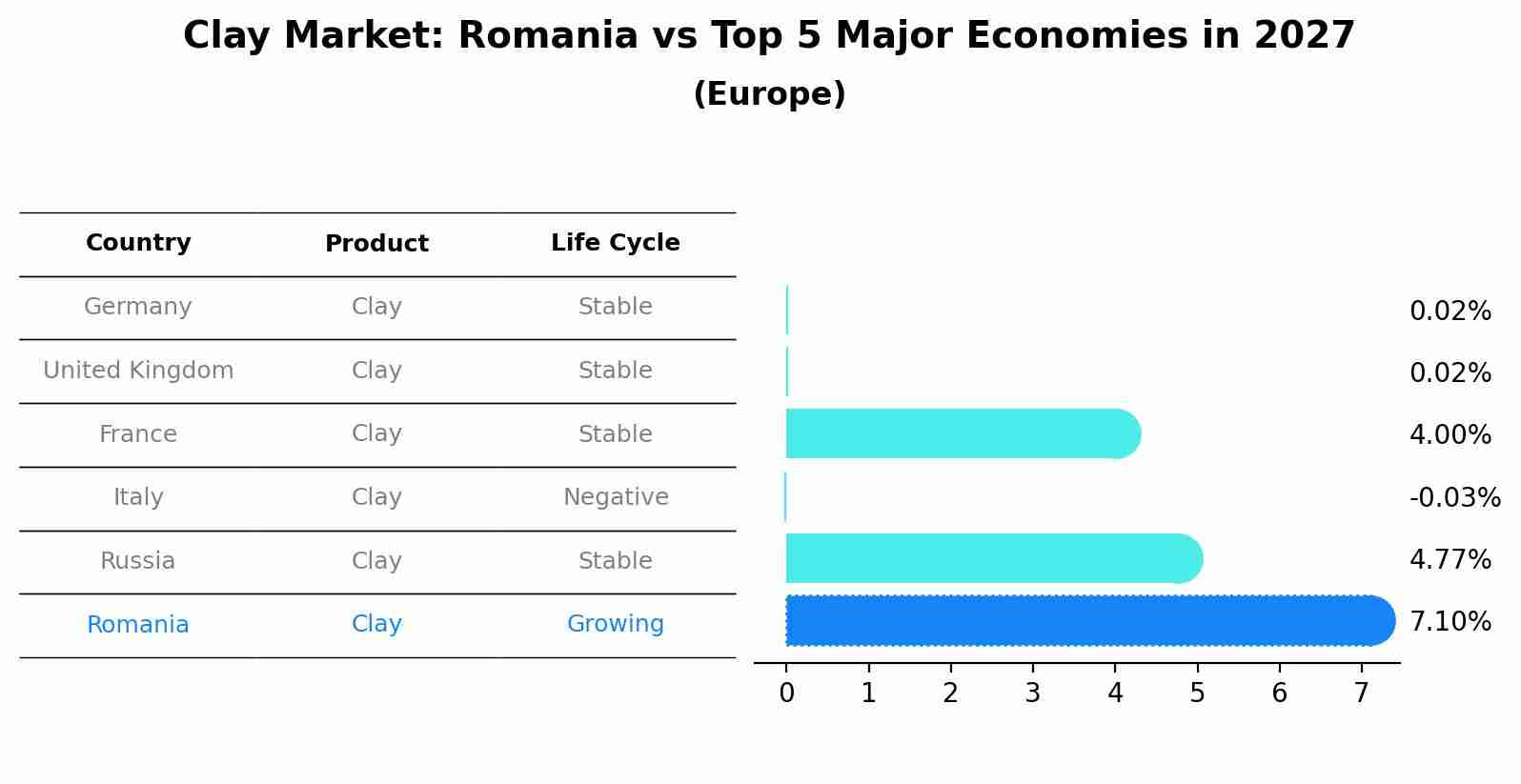Romania Clay Market Outlook | Trends, Companies, Revenue, Forecast, COVID-19 IMPACT, Industry, Size, Share, Growth, Analysis & Value
| Product Code: ETC318978 | Publication Date: Aug 2022 | Updated Date: Aug 2025 | Product Type: Market Research Report | |
| Publisher: 6Wresearch | Author: Shubham Padhi | No. of Pages: 75 | No. of Figures: 35 | No. of Tables: 20 |
Romania Clay Market Size Growth Rate
The Romania Clay Market is projected to witness mixed growth rate patterns during 2025 to 2029. Commencing at 8.71% in 2025, growth builds up to 15.60% by 2029.

Clay Market: Romania vs Top 5 Major Economies in 2027 (Europe)
The Clay market in Romania is projected to grow at a growing growth rate of 7.10% by 2027, highlighting the country's increasing focus on advanced technologies within the Europe region, where Germany holds the dominant position, followed closely by United Kingdom, France, Italy and Russia, shaping overall regional demand.

Romania Clay Market Overview
Clay is a fundamental material in various industries in Romania, including construction, ceramics, and pharmaceuticals. The Romania clay market is characterized by abundant local clay deposits, driving domestic production and export activities. The market dynamics are influenced by infrastructure development, urbanization trends, and technological advancements in clay processing.
Drivers of the market
The Romania Clay Market is driven by the expanding construction and infrastructure sectors, where clay is extensively used in the production of bricks, tiles, ceramics, and other building materials. The steady growth in residential and commercial construction activities, coupled with infrastructure development projects, fuels the demand for clay products. Moreover, the increasing popularity of eco-friendly and sustainable building materials has further boosted the market, as clay products are known for their durability, thermal insulation properties, and aesthetic appeal.
Challenges of the market
The clay market in Romania faces challenges related to raw material procurement and quality consistency. Variations in clay composition and availability can impact product quality and manufacturing processes, affecting the competitiveness of local clay producers. Moreover, fluctuations in raw material costs and logistics challenges can increase production expenses, thereby affecting pricing strategies and profitability. Additionally, competition from imported clay products adds pressure to domestic manufacturers to enhance their product offerings and operational efficiencies to maintain market share in the face of global competition.
Government Policy of the market
The Romanian government supports the mining and extraction industries, including clay mining, through regulations that ensure sustainable extraction practices and environmental protection. Policies also encourage the use of domestically sourced clay in manufacturing to promote local industries.
Key Highlights of the Report:
- Romania Clay Market Outlook
- Market Size of Romania Clay Market, 2024
- Forecast of Romania Clay Market, 2031
- Historical Data and Forecast of Romania Clay Revenues & Volume for the Period 2018 - 2031
- Romania Clay Market Trend Evolution
- Romania Clay Market Drivers and Challenges
- Romania Clay Price Trends
- Romania Clay Porter's Five Forces
- Romania Clay Industry Life Cycle
- Historical Data and Forecast of Romania Clay Market Revenues & Volume By Application for the Period 2018 - 2031
- Historical Data and Forecast of Romania Clay Market Revenues & Volume By Tableware for the Period 2018 - 2031
- Historical Data and Forecast of Romania Clay Market Revenues & Volume By Sanitary ware for the Period 2018 - 2031
- Historical Data and Forecast of Romania Clay Market Revenues & Volume By Medical applications for the Period 2018 - 2031
- Historical Data and Forecast of Romania Clay Market Revenues & Volume By End Use for the Period 2018 - 2031
- Historical Data and Forecast of Romania Clay Market Revenues & Volume By Ceramic and for the Period 2018 - 2031
- Historical Data and Forecast of Romania Clay Market Revenues & Volume By Non-ceramic for the Period 2018 - 2031
- Romania Clay Import Export Trade Statistics
- Market Opportunity Assessment By Application
- Market Opportunity Assessment By End Use
- Romania Clay Top Companies Market Share
- Romania Clay Competitive Benchmarking By Technical and Operational Parameters
- Romania Clay Company Profiles
- Romania Clay Key Strategic Recommendations
Frequently Asked Questions About the Market Study (FAQs):
1 Executive Summary |
2 Introduction |
2.1 Key Highlights of the Report |
2.2 Report Description |
2.3 Market Scope & Segmentation |
2.4 Research Methodology |
2.5 Assumptions |
3 Romania Clay Market Overview |
3.1 Romania Country Macro Economic Indicators |
3.2 Romania Clay Market Revenues & Volume, 2021 & 2031F |
3.3 Romania Clay Market - Industry Life Cycle |
3.4 Romania Clay Market - Porter's Five Forces |
3.5 Romania Clay Market Revenues & Volume Share, By Application, 2021 & 2031F |
3.6 Romania Clay Market Revenues & Volume Share, By End Use, 2021 & 2031F |
4 Romania Clay Market Dynamics |
4.1 Impact Analysis |
4.2 Market Drivers |
4.2.1 Growing demand for clay in the construction industry due to its versatile applications in areas such as bricks, tiles, and ceramics. |
4.2.2 Increasing focus on sustainable and eco-friendly building materials, with clay being a natural and renewable resource. |
4.2.3 Government initiatives promoting infrastructure development, which boosts the demand for clay-based products. |
4.3 Market Restraints |
4.3.1 Fluctuations in raw material prices impacting the cost of clay production. |
4.3.2 Competition from alternative materials like concrete and synthetic polymers posing a challenge to the clay market. |
4.3.3 Environmental regulations and concerns regarding clay mining and processing affecting the industry's operations. |
5 Romania Clay Market Trends |
6 Romania Clay Market, By Types |
6.1 Romania Clay Market, By Application |
6.1.1 Overview and Analysis |
6.1.2 Romania Clay Market Revenues & Volume, By Application, 2021-2031F |
6.1.3 Romania Clay Market Revenues & Volume, By Tableware, 2021-2031F |
6.1.4 Romania Clay Market Revenues & Volume, By Sanitary ware, 2021-2031F |
6.1.5 Romania Clay Market Revenues & Volume, By Medical applications, 2021-2031F |
6.2 Romania Clay Market, By End Use |
6.2.1 Overview and Analysis |
6.2.2 Romania Clay Market Revenues & Volume, By Ceramic and, 2021-2031F |
6.2.3 Romania Clay Market Revenues & Volume, By Non-ceramic, 2021-2031F |
7 Romania Clay Market Import-Export Trade Statistics |
7.1 Romania Clay Market Export to Major Countries |
7.2 Romania Clay Market Imports from Major Countries |
8 Romania Clay Market Key Performance Indicators |
8.1 Average selling price of clay products indicating market demand and pricing trends. |
8.2 Number of new construction projects utilizing clay-based materials as a measure of market penetration. |
8.3 Investment in research and development for innovative clay products showcasing industry innovation and growth potential. |
9 Romania Clay Market - Opportunity Assessment |
9.1 Romania Clay Market Opportunity Assessment, By Application, 2021 & 2031F |
9.2 Romania Clay Market Opportunity Assessment, By End Use, 2021 & 2031F |
10 Romania Clay Market - Competitive Landscape |
10.1 Romania Clay Market Revenue Share, By Companies, 2024 |
10.2 Romania Clay Market Competitive Benchmarking, By Operating and Technical Parameters |
11 Company Profiles |
12 Recommendations |
13 Disclaimer |
- Single User License$ 1,995
- Department License$ 2,400
- Site License$ 3,120
- Global License$ 3,795
Search
Related Reports
- ASEAN and Thailand Brain Health Supplements Market (2025-2031) | Strategy, Consumer Insights, Analysis, Investment Trends, Opportunities, Growth, Size, Share, Industry, Revenue, Segments, Value, Segmentation, Supply, Forecast, Restraints, Outlook, Competition, Drivers, Trends, Demand, Pricing Analysis, Competitive, Strategic Insights, Companies, Challenges
- ASEAN Bearings Market (2025-2031) | Strategy, Consumer Insights, Analysis, Investment Trends, Opportunities, Growth, Size, Share, Industry, Revenue, Segments, Value, Segmentation, Supply, Forecast, Restraints, Outlook, Competition, Drivers, Trends, Demand, Pricing Analysis, Competitive, Strategic Insights, Companies, Challenges
- Europe Flooring Market (2025-2031) | Outlook, Share, Industry, Trends, Forecast, Companies, Revenue, Size, Analysis, Growth & Value
- Saudi Arabia Manlift Market (2025-2031) | Outlook, Size, Growth, Trends, Companies, Industry, Revenue, Value, Share, Forecast & Analysis
- Uganda Excavator, Crane, and Wheel Loaders Market (2025-2031) | Strategy, Consumer Insights, Analysis, Investment Trends, Opportunities, Growth, Size, Share, Industry, Revenue, Segments, Value, Segmentation, Supply, Forecast, Restraints, Outlook, Competition, Drivers, Trends, Demand, Pricing Analysis, Competitive, Strategic Insights, Companies, Challenges
- Rwanda Excavator, Crane, and Wheel Loaders Market (2025-2031) | Strategy, Consumer Insights, Analysis, Investment Trends, Opportunities, Growth, Size, Share, Industry, Revenue, Segments, Value, Segmentation, Supply, Forecast, Restraints, Outlook, Competition, Drivers, Trends, Demand, Pricing Analysis, Competitive, Strategic Insights, Companies, Challenges
- Kenya Excavator, Crane, and Wheel Loaders Market (2025-2031) | Strategy, Consumer Insights, Analysis, Investment Trends, Opportunities, Growth, Size, Share, Industry, Revenue, Segments, Value, Segmentation, Supply, Forecast, Restraints, Outlook, Competition, Drivers, Trends, Demand, Pricing Analysis, Competitive, Strategic Insights, Companies, Challenges
- Angola Excavator, Crane, and Wheel Loaders Market (2025-2031) | Strategy, Consumer Insights, Analysis, Investment Trends, Opportunities, Growth, Size, Share, Industry, Revenue, Segments, Value, Segmentation, Supply, Forecast, Restraints, Outlook, Competition, Drivers, Trends, Demand, Pricing Analysis, Competitive, Strategic Insights, Companies, Challenges
- Israel Intelligent Transport System Market (2025-2031) | Strategy, Consumer Insights, Analysis, Investment Trends, Opportunities, Growth, Size, Share, Industry, Revenue, Segments, Value, Segmentation, Supply, Forecast, Restraints, Outlook, Competition, Drivers, Trends, Demand, Pricing Analysis, Competitive, Strategic Insights, Companies, Challenges
- Uganda Precast and Aggregate Market (2025-2031) | Strategy, Consumer Insights, Analysis, Investment Trends, Opportunities, Growth, Size, Share, Industry, Revenue, Segments, Value, Segmentation, Supply, Forecast, Restraints, Outlook, Competition, Drivers, Trends, Demand, Pricing Analysis, Competitive, Strategic Insights, Companies, Challenges
Industry Events and Analyst Meet
Our Clients
Whitepaper
- Middle East & Africa Commercial Security Market Click here to view more.
- Middle East & Africa Fire Safety Systems & Equipment Market Click here to view more.
- GCC Drone Market Click here to view more.
- Middle East Lighting Fixture Market Click here to view more.
- GCC Physical & Perimeter Security Market Click here to view more.
6WResearch In News
- Doha a strategic location for EV manufacturing hub: IPA Qatar
- Demand for luxury TVs surging in the GCC, says Samsung
- Empowering Growth: The Thriving Journey of Bangladesh’s Cable Industry
- Demand for luxury TVs surging in the GCC, says Samsung
- Video call with a traditional healer? Once unthinkable, it’s now common in South Africa
- Intelligent Buildings To Smooth GCC’s Path To Net Zero













